Influencing and Making Decisions: A Comparative Analysis of Modes
VerifiedAdded on 2020/05/11
|14
|3804
|77
Report
AI Summary
This report examines various decision-making processes within a business context, focusing on deliberative, intuitive, and considerate modes, along with rational and administrative decision-making models. It begins with an executive summary outlining the aim of the paper, which is to study different decision-making processes and reflect on the author's own decision-making approach within their organization. The introduction defines decision-making as a cognitive process of selecting actions and categorizes it into individual and group decision-making, further dividing these into various types. The report delves into decision-making concepts such as intuitive, considerate, and deliberative modes, and analyzes rational and administrative decision-making models. It also offers an argumentative reflection on the author's preferred decision-making mode compared to others. The report discusses the impact of the changing workplace environment on decision-making, highlighting the pressures on decision-makers and the importance of considering stakeholder emotions and values. The report also includes a discussion on the benefits and drawbacks of each mode, emphasizing the potential for cooperative application of the modes in complex situations, and concludes with the author's reflection on how they can improve their decision-making process. References are provided to support the arguments presented.
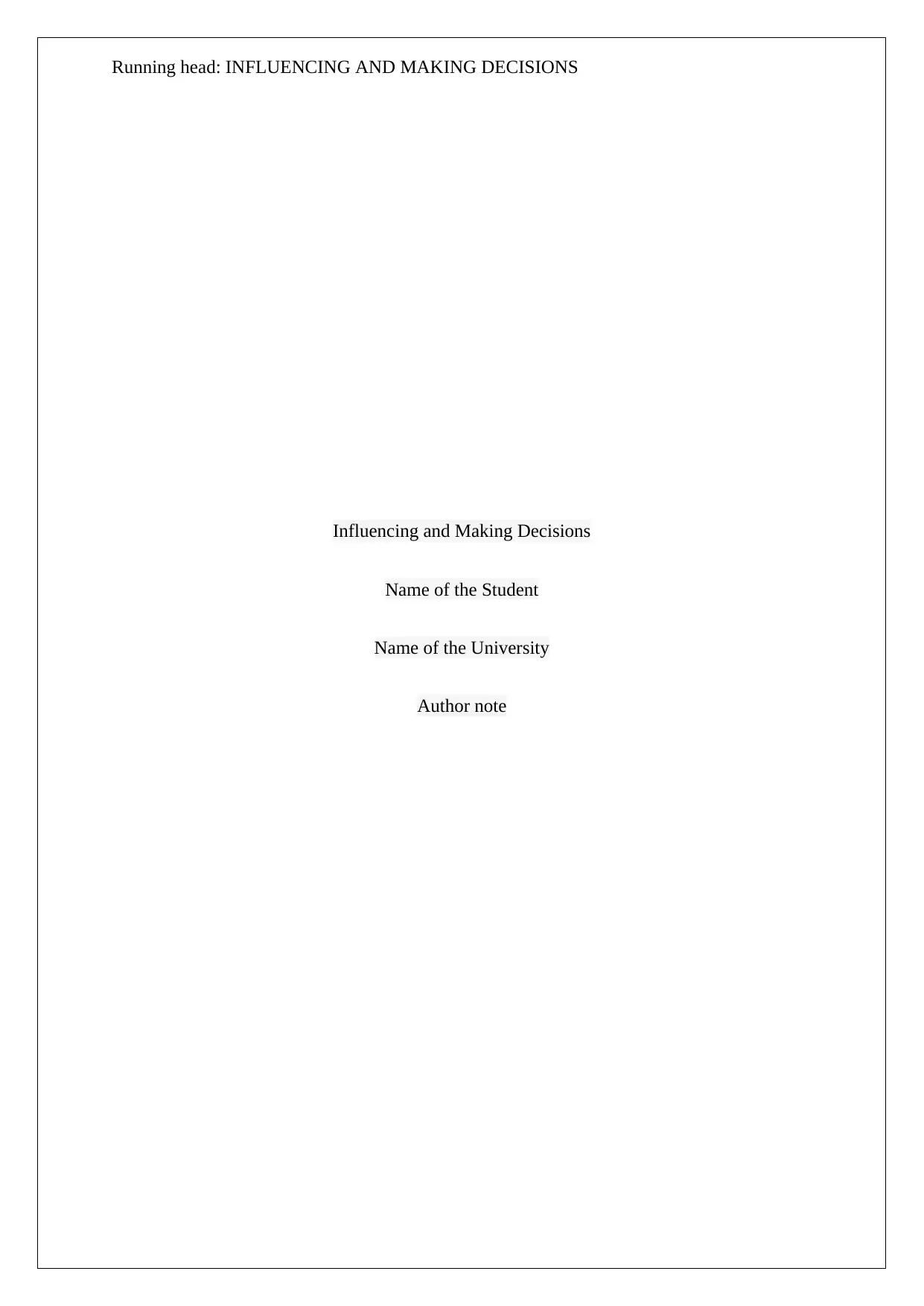
Running head: INFLUENCING AND MAKING DECISIONS
Influencing and Making Decisions
Name of the Student
Name of the University
Author note
Influencing and Making Decisions
Name of the Student
Name of the University
Author note
Paraphrase This Document
Need a fresh take? Get an instant paraphrase of this document with our AI Paraphraser
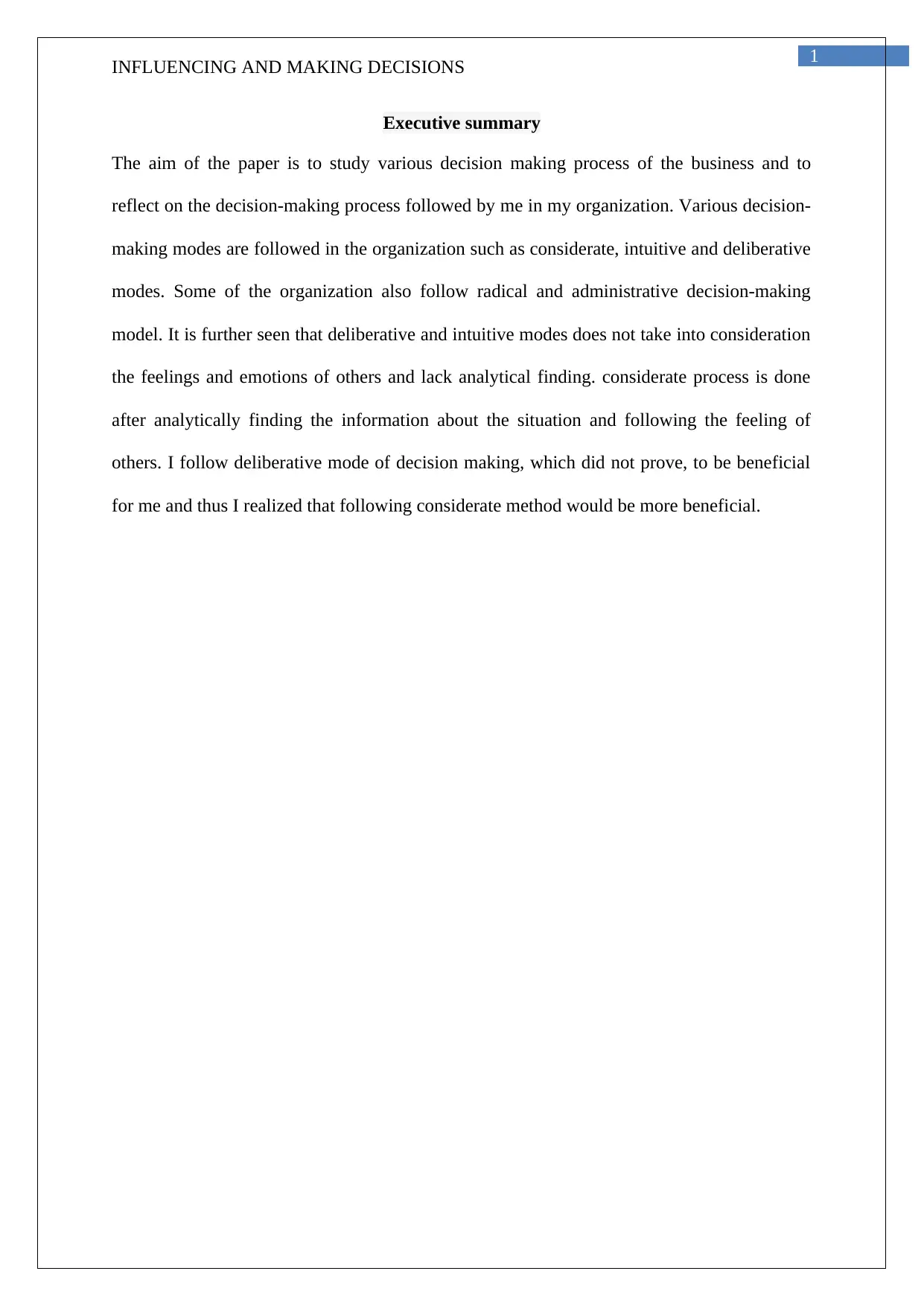
1
INFLUENCING AND MAKING DECISIONS
Executive summary
The aim of the paper is to study various decision making process of the business and to
reflect on the decision-making process followed by me in my organization. Various decision-
making modes are followed in the organization such as considerate, intuitive and deliberative
modes. Some of the organization also follow radical and administrative decision-making
model. It is further seen that deliberative and intuitive modes does not take into consideration
the feelings and emotions of others and lack analytical finding. considerate process is done
after analytically finding the information about the situation and following the feeling of
others. I follow deliberative mode of decision making, which did not prove, to be beneficial
for me and thus I realized that following considerate method would be more beneficial.
INFLUENCING AND MAKING DECISIONS
Executive summary
The aim of the paper is to study various decision making process of the business and to
reflect on the decision-making process followed by me in my organization. Various decision-
making modes are followed in the organization such as considerate, intuitive and deliberative
modes. Some of the organization also follow radical and administrative decision-making
model. It is further seen that deliberative and intuitive modes does not take into consideration
the feelings and emotions of others and lack analytical finding. considerate process is done
after analytically finding the information about the situation and following the feeling of
others. I follow deliberative mode of decision making, which did not prove, to be beneficial
for me and thus I realized that following considerate method would be more beneficial.
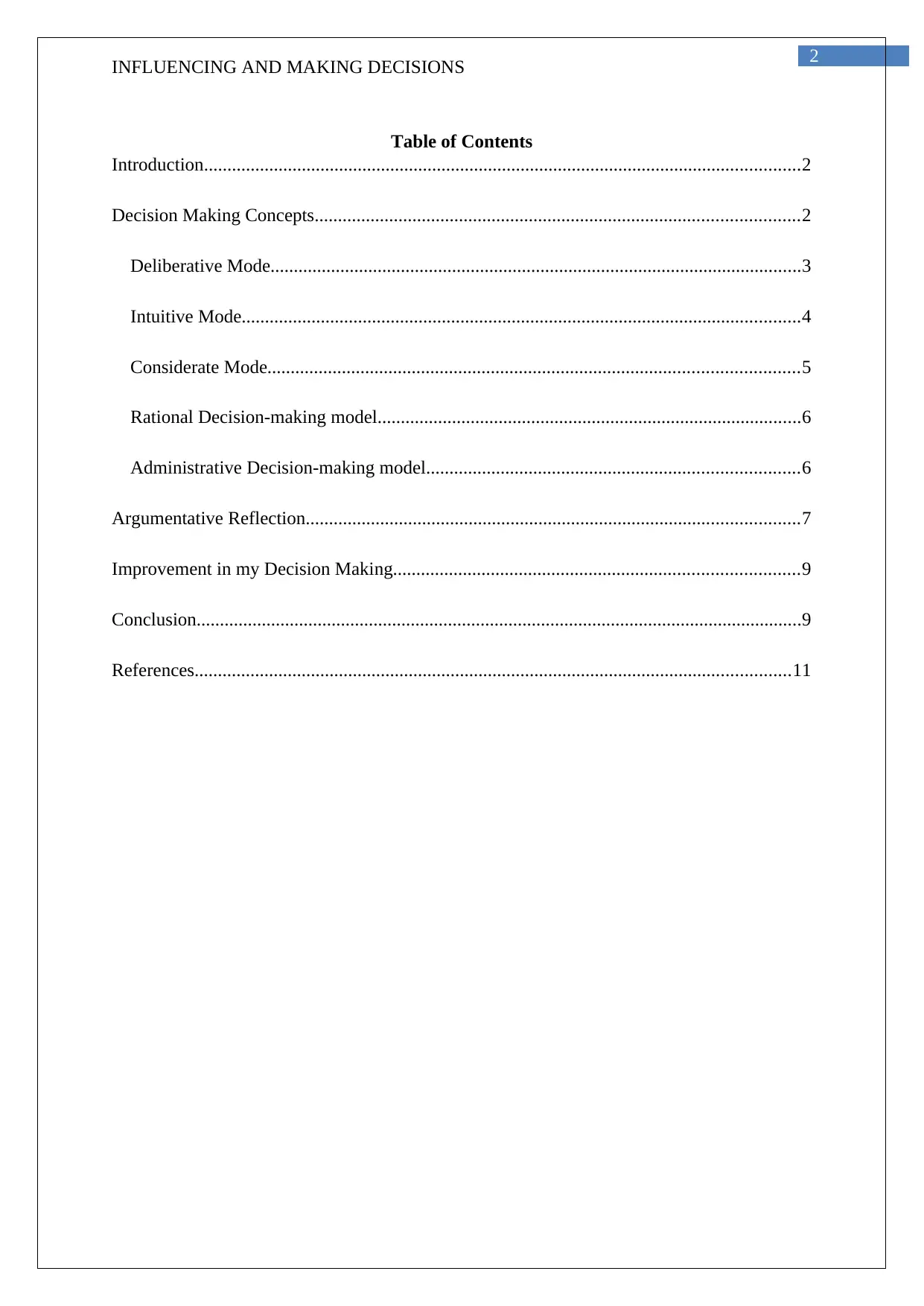
2
INFLUENCING AND MAKING DECISIONS
Table of Contents
Introduction................................................................................................................................2
Decision Making Concepts........................................................................................................2
Deliberative Mode..................................................................................................................3
Intuitive Mode........................................................................................................................4
Considerate Mode..................................................................................................................5
Rational Decision-making model...........................................................................................6
Administrative Decision-making model................................................................................6
Argumentative Reflection..........................................................................................................7
Improvement in my Decision Making.......................................................................................9
Conclusion..................................................................................................................................9
References................................................................................................................................11
INFLUENCING AND MAKING DECISIONS
Table of Contents
Introduction................................................................................................................................2
Decision Making Concepts........................................................................................................2
Deliberative Mode..................................................................................................................3
Intuitive Mode........................................................................................................................4
Considerate Mode..................................................................................................................5
Rational Decision-making model...........................................................................................6
Administrative Decision-making model................................................................................6
Argumentative Reflection..........................................................................................................7
Improvement in my Decision Making.......................................................................................9
Conclusion..................................................................................................................................9
References................................................................................................................................11
⊘ This is a preview!⊘
Do you want full access?
Subscribe today to unlock all pages.

Trusted by 1+ million students worldwide
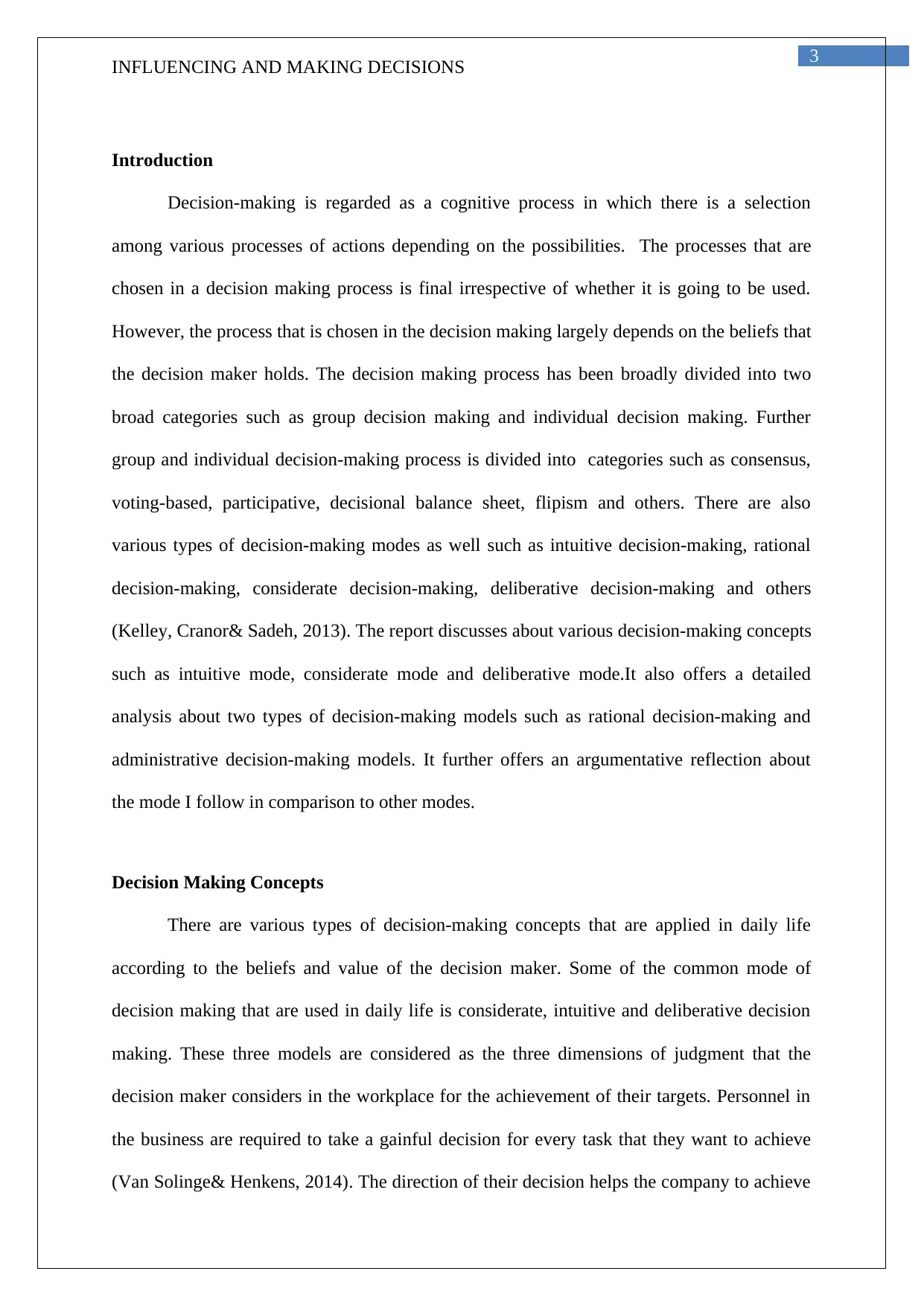
3
INFLUENCING AND MAKING DECISIONS
Introduction
Decision-making is regarded as a cognitive process in which there is a selection
among various processes of actions depending on the possibilities. The processes that are
chosen in a decision making process is final irrespective of whether it is going to be used.
However, the process that is chosen in the decision making largely depends on the beliefs that
the decision maker holds. The decision making process has been broadly divided into two
broad categories such as group decision making and individual decision making. Further
group and individual decision-making process is divided into categories such as consensus,
voting-based, participative, decisional balance sheet, flipism and others. There are also
various types of decision-making modes as well such as intuitive decision-making, rational
decision-making, considerate decision-making, deliberative decision-making and others
(Kelley, Cranor& Sadeh, 2013). The report discusses about various decision-making concepts
such as intuitive mode, considerate mode and deliberative mode.It also offers a detailed
analysis about two types of decision-making models such as rational decision-making and
administrative decision-making models. It further offers an argumentative reflection about
the mode I follow in comparison to other modes.
Decision Making Concepts
There are various types of decision-making concepts that are applied in daily life
according to the beliefs and value of the decision maker. Some of the common mode of
decision making that are used in daily life is considerate, intuitive and deliberative decision
making. These three models are considered as the three dimensions of judgment that the
decision maker considers in the workplace for the achievement of their targets. Personnel in
the business are required to take a gainful decision for every task that they want to achieve
(Van Solinge& Henkens, 2014). The direction of their decision helps the company to achieve
INFLUENCING AND MAKING DECISIONS
Introduction
Decision-making is regarded as a cognitive process in which there is a selection
among various processes of actions depending on the possibilities. The processes that are
chosen in a decision making process is final irrespective of whether it is going to be used.
However, the process that is chosen in the decision making largely depends on the beliefs that
the decision maker holds. The decision making process has been broadly divided into two
broad categories such as group decision making and individual decision making. Further
group and individual decision-making process is divided into categories such as consensus,
voting-based, participative, decisional balance sheet, flipism and others. There are also
various types of decision-making modes as well such as intuitive decision-making, rational
decision-making, considerate decision-making, deliberative decision-making and others
(Kelley, Cranor& Sadeh, 2013). The report discusses about various decision-making concepts
such as intuitive mode, considerate mode and deliberative mode.It also offers a detailed
analysis about two types of decision-making models such as rational decision-making and
administrative decision-making models. It further offers an argumentative reflection about
the mode I follow in comparison to other modes.
Decision Making Concepts
There are various types of decision-making concepts that are applied in daily life
according to the beliefs and value of the decision maker. Some of the common mode of
decision making that are used in daily life is considerate, intuitive and deliberative decision
making. These three models are considered as the three dimensions of judgment that the
decision maker considers in the workplace for the achievement of their targets. Personnel in
the business are required to take a gainful decision for every task that they want to achieve
(Van Solinge& Henkens, 2014). The direction of their decision helps the company to achieve
Paraphrase This Document
Need a fresh take? Get an instant paraphrase of this document with our AI Paraphraser
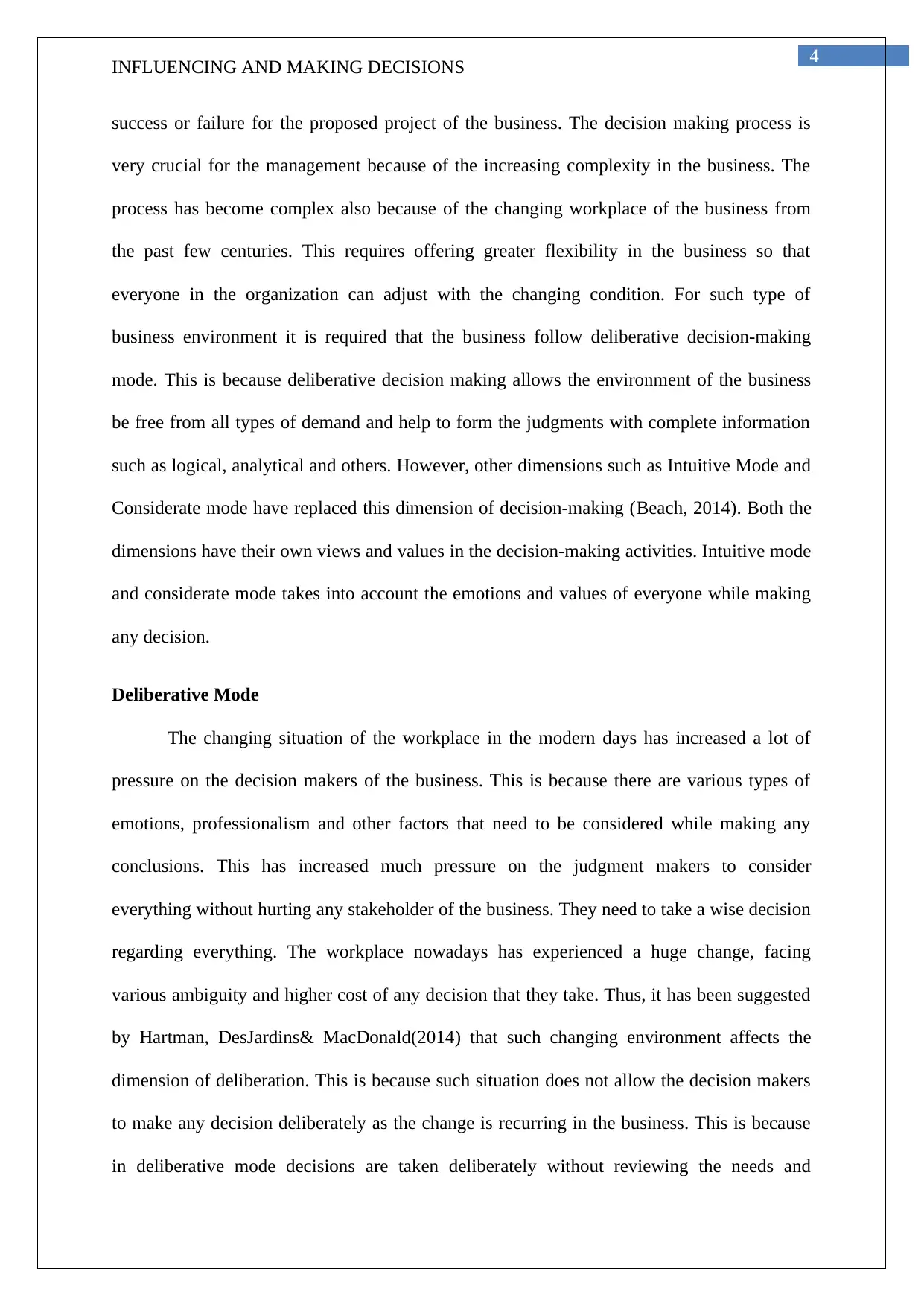
4
INFLUENCING AND MAKING DECISIONS
success or failure for the proposed project of the business. The decision making process is
very crucial for the management because of the increasing complexity in the business. The
process has become complex also because of the changing workplace of the business from
the past few centuries. This requires offering greater flexibility in the business so that
everyone in the organization can adjust with the changing condition. For such type of
business environment it is required that the business follow deliberative decision-making
mode. This is because deliberative decision making allows the environment of the business
be free from all types of demand and help to form the judgments with complete information
such as logical, analytical and others. However, other dimensions such as Intuitive Mode and
Considerate mode have replaced this dimension of decision-making (Beach, 2014). Both the
dimensions have their own views and values in the decision-making activities. Intuitive mode
and considerate mode takes into account the emotions and values of everyone while making
any decision.
Deliberative Mode
The changing situation of the workplace in the modern days has increased a lot of
pressure on the decision makers of the business. This is because there are various types of
emotions, professionalism and other factors that need to be considered while making any
conclusions. This has increased much pressure on the judgment makers to consider
everything without hurting any stakeholder of the business. They need to take a wise decision
regarding everything. The workplace nowadays has experienced a huge change, facing
various ambiguity and higher cost of any decision that they take. Thus, it has been suggested
by Hartman, DesJardins& MacDonald(2014) that such changing environment affects the
dimension of deliberation. This is because such situation does not allow the decision makers
to make any decision deliberately as the change is recurring in the business. This is because
in deliberative mode decisions are taken deliberately without reviewing the needs and
INFLUENCING AND MAKING DECISIONS
success or failure for the proposed project of the business. The decision making process is
very crucial for the management because of the increasing complexity in the business. The
process has become complex also because of the changing workplace of the business from
the past few centuries. This requires offering greater flexibility in the business so that
everyone in the organization can adjust with the changing condition. For such type of
business environment it is required that the business follow deliberative decision-making
mode. This is because deliberative decision making allows the environment of the business
be free from all types of demand and help to form the judgments with complete information
such as logical, analytical and others. However, other dimensions such as Intuitive Mode and
Considerate mode have replaced this dimension of decision-making (Beach, 2014). Both the
dimensions have their own views and values in the decision-making activities. Intuitive mode
and considerate mode takes into account the emotions and values of everyone while making
any decision.
Deliberative Mode
The changing situation of the workplace in the modern days has increased a lot of
pressure on the decision makers of the business. This is because there are various types of
emotions, professionalism and other factors that need to be considered while making any
conclusions. This has increased much pressure on the judgment makers to consider
everything without hurting any stakeholder of the business. They need to take a wise decision
regarding everything. The workplace nowadays has experienced a huge change, facing
various ambiguity and higher cost of any decision that they take. Thus, it has been suggested
by Hartman, DesJardins& MacDonald(2014) that such changing environment affects the
dimension of deliberation. This is because such situation does not allow the decision makers
to make any decision deliberately as the change is recurring in the business. This is because
in deliberative mode decisions are taken deliberately without reviewing the needs and
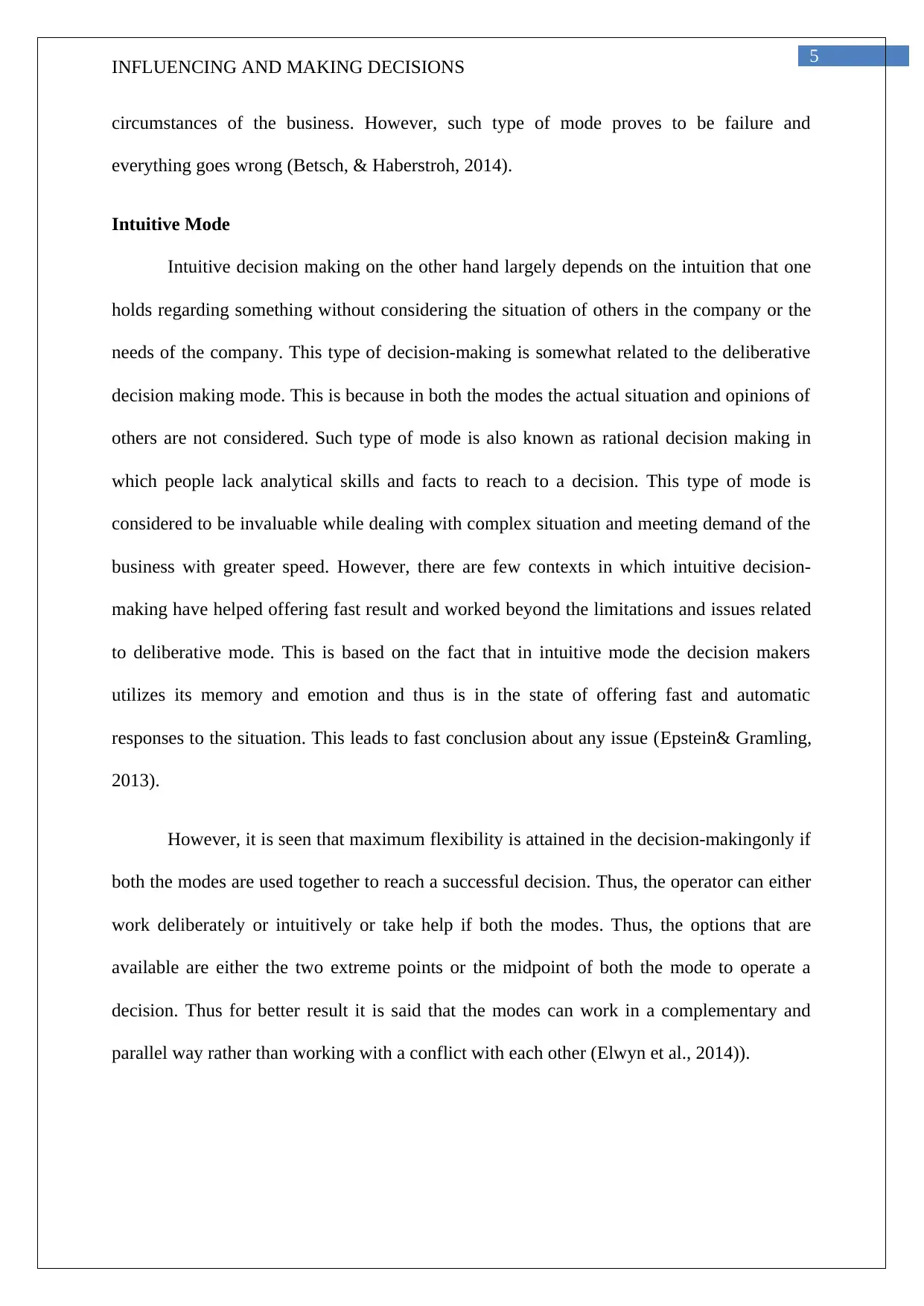
5
INFLUENCING AND MAKING DECISIONS
circumstances of the business. However, such type of mode proves to be failure and
everything goes wrong (Betsch, & Haberstroh, 2014).
Intuitive Mode
Intuitive decision making on the other hand largely depends on the intuition that one
holds regarding something without considering the situation of others in the company or the
needs of the company. This type of decision-making is somewhat related to the deliberative
decision making mode. This is because in both the modes the actual situation and opinions of
others are not considered. Such type of mode is also known as rational decision making in
which people lack analytical skills and facts to reach to a decision. This type of mode is
considered to be invaluable while dealing with complex situation and meeting demand of the
business with greater speed. However, there are few contexts in which intuitive decision-
making have helped offering fast result and worked beyond the limitations and issues related
to deliberative mode. This is based on the fact that in intuitive mode the decision makers
utilizes its memory and emotion and thus is in the state of offering fast and automatic
responses to the situation. This leads to fast conclusion about any issue (Epstein& Gramling,
2013).
However, it is seen that maximum flexibility is attained in the decision-makingonly if
both the modes are used together to reach a successful decision. Thus, the operator can either
work deliberately or intuitively or take help if both the modes. Thus, the options that are
available are either the two extreme points or the midpoint of both the mode to operate a
decision. Thus for better result it is said that the modes can work in a complementary and
parallel way rather than working with a conflict with each other (Elwyn et al., 2014)).
INFLUENCING AND MAKING DECISIONS
circumstances of the business. However, such type of mode proves to be failure and
everything goes wrong (Betsch, & Haberstroh, 2014).
Intuitive Mode
Intuitive decision making on the other hand largely depends on the intuition that one
holds regarding something without considering the situation of others in the company or the
needs of the company. This type of decision-making is somewhat related to the deliberative
decision making mode. This is because in both the modes the actual situation and opinions of
others are not considered. Such type of mode is also known as rational decision making in
which people lack analytical skills and facts to reach to a decision. This type of mode is
considered to be invaluable while dealing with complex situation and meeting demand of the
business with greater speed. However, there are few contexts in which intuitive decision-
making have helped offering fast result and worked beyond the limitations and issues related
to deliberative mode. This is based on the fact that in intuitive mode the decision makers
utilizes its memory and emotion and thus is in the state of offering fast and automatic
responses to the situation. This leads to fast conclusion about any issue (Epstein& Gramling,
2013).
However, it is seen that maximum flexibility is attained in the decision-makingonly if
both the modes are used together to reach a successful decision. Thus, the operator can either
work deliberately or intuitively or take help if both the modes. Thus, the options that are
available are either the two extreme points or the midpoint of both the mode to operate a
decision. Thus for better result it is said that the modes can work in a complementary and
parallel way rather than working with a conflict with each other (Elwyn et al., 2014)).
⊘ This is a preview!⊘
Do you want full access?
Subscribe today to unlock all pages.

Trusted by 1+ million students worldwide
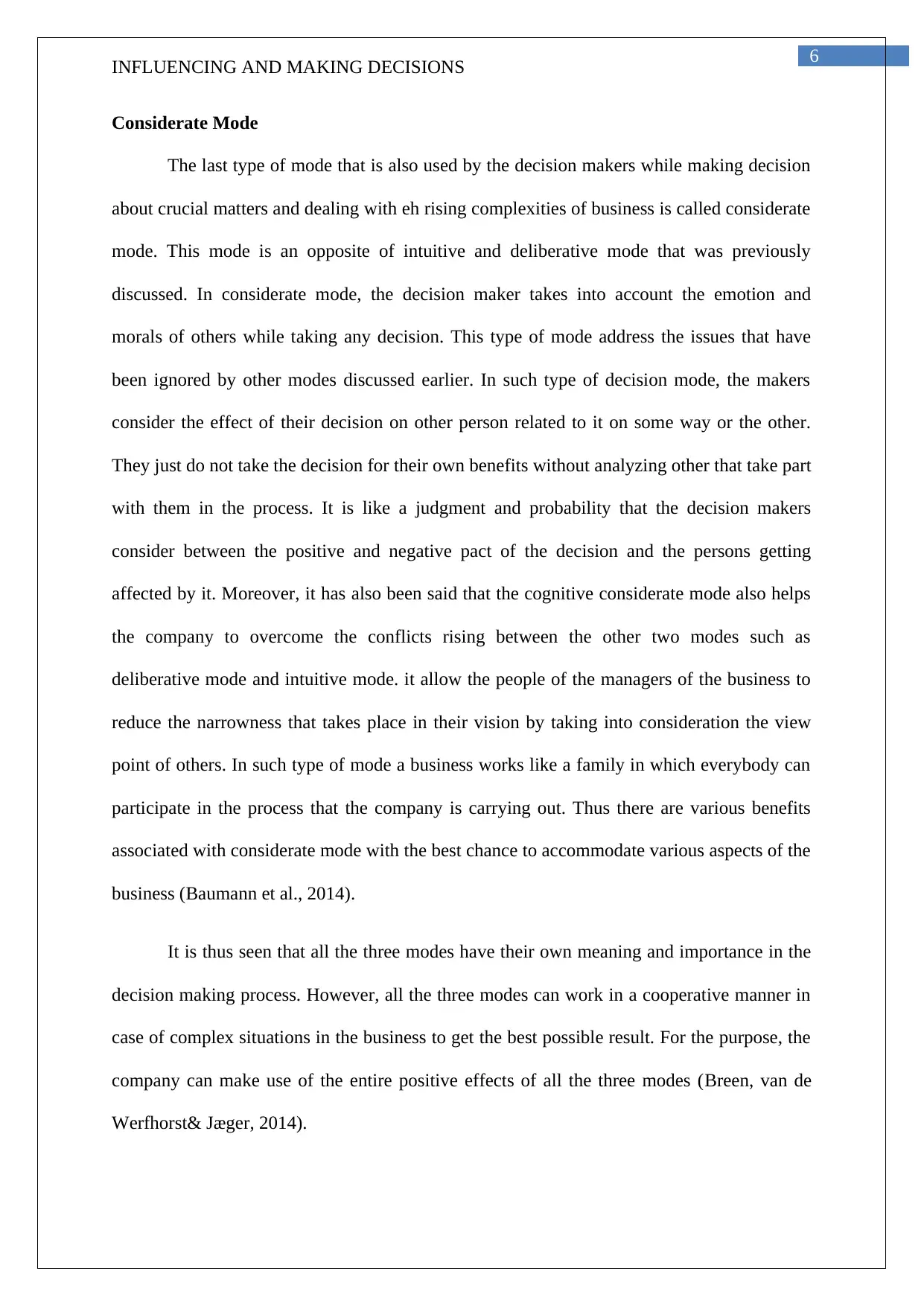
6
INFLUENCING AND MAKING DECISIONS
Considerate Mode
The last type of mode that is also used by the decision makers while making decision
about crucial matters and dealing with eh rising complexities of business is called considerate
mode. This mode is an opposite of intuitive and deliberative mode that was previously
discussed. In considerate mode, the decision maker takes into account the emotion and
morals of others while taking any decision. This type of mode address the issues that have
been ignored by other modes discussed earlier. In such type of decision mode, the makers
consider the effect of their decision on other person related to it on some way or the other.
They just do not take the decision for their own benefits without analyzing other that take part
with them in the process. It is like a judgment and probability that the decision makers
consider between the positive and negative pact of the decision and the persons getting
affected by it. Moreover, it has also been said that the cognitive considerate mode also helps
the company to overcome the conflicts rising between the other two modes such as
deliberative mode and intuitive mode. it allow the people of the managers of the business to
reduce the narrowness that takes place in their vision by taking into consideration the view
point of others. In such type of mode a business works like a family in which everybody can
participate in the process that the company is carrying out. Thus there are various benefits
associated with considerate mode with the best chance to accommodate various aspects of the
business (Baumann et al., 2014).
It is thus seen that all the three modes have their own meaning and importance in the
decision making process. However, all the three modes can work in a cooperative manner in
case of complex situations in the business to get the best possible result. For the purpose, the
company can make use of the entire positive effects of all the three modes (Breen, van de
Werfhorst& Jæger, 2014).
INFLUENCING AND MAKING DECISIONS
Considerate Mode
The last type of mode that is also used by the decision makers while making decision
about crucial matters and dealing with eh rising complexities of business is called considerate
mode. This mode is an opposite of intuitive and deliberative mode that was previously
discussed. In considerate mode, the decision maker takes into account the emotion and
morals of others while taking any decision. This type of mode address the issues that have
been ignored by other modes discussed earlier. In such type of decision mode, the makers
consider the effect of their decision on other person related to it on some way or the other.
They just do not take the decision for their own benefits without analyzing other that take part
with them in the process. It is like a judgment and probability that the decision makers
consider between the positive and negative pact of the decision and the persons getting
affected by it. Moreover, it has also been said that the cognitive considerate mode also helps
the company to overcome the conflicts rising between the other two modes such as
deliberative mode and intuitive mode. it allow the people of the managers of the business to
reduce the narrowness that takes place in their vision by taking into consideration the view
point of others. In such type of mode a business works like a family in which everybody can
participate in the process that the company is carrying out. Thus there are various benefits
associated with considerate mode with the best chance to accommodate various aspects of the
business (Baumann et al., 2014).
It is thus seen that all the three modes have their own meaning and importance in the
decision making process. However, all the three modes can work in a cooperative manner in
case of complex situations in the business to get the best possible result. For the purpose, the
company can make use of the entire positive effects of all the three modes (Breen, van de
Werfhorst& Jæger, 2014).
Paraphrase This Document
Need a fresh take? Get an instant paraphrase of this document with our AI Paraphraser
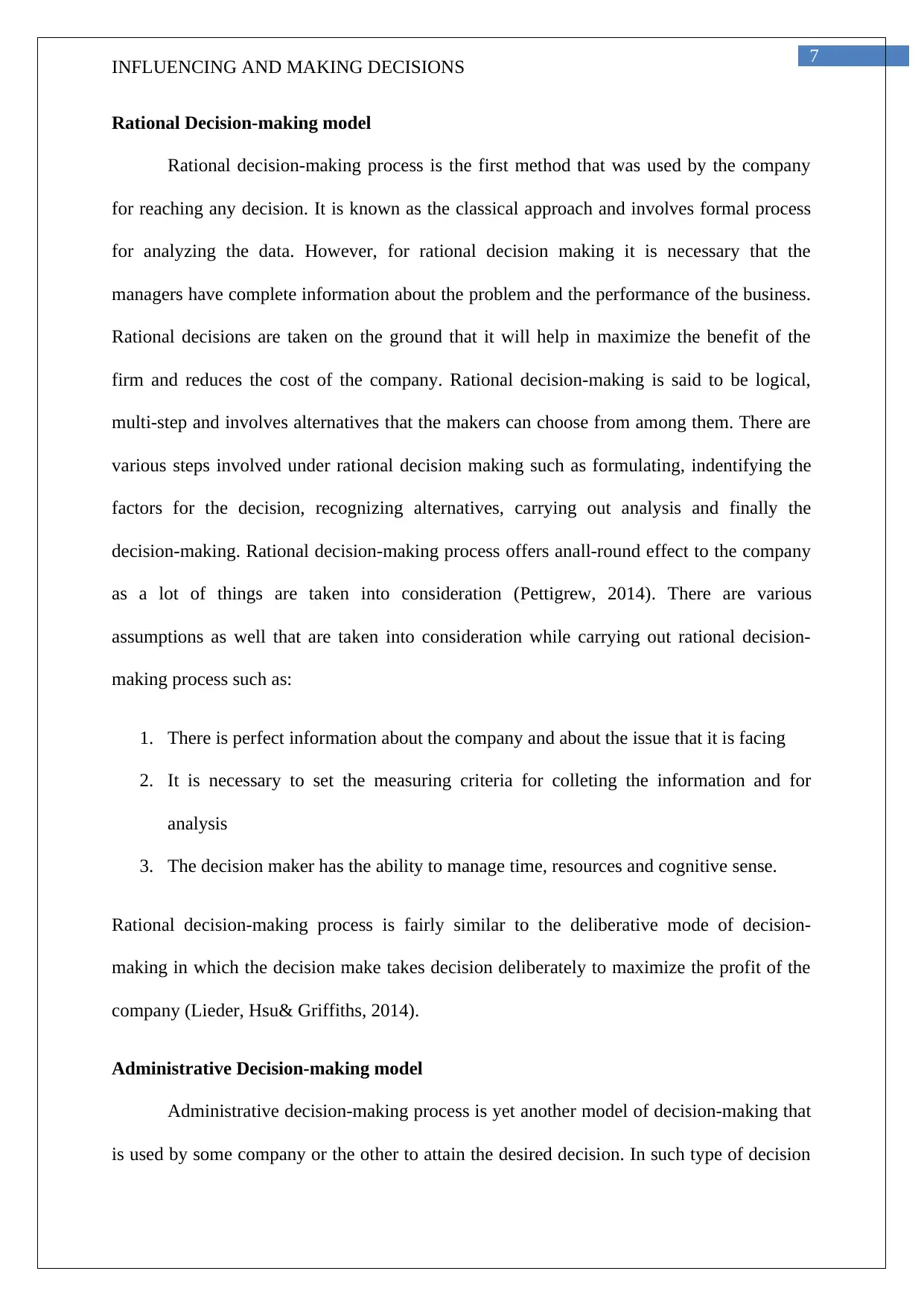
7
INFLUENCING AND MAKING DECISIONS
Rational Decision-making model
Rational decision-making process is the first method that was used by the company
for reaching any decision. It is known as the classical approach and involves formal process
for analyzing the data. However, for rational decision making it is necessary that the
managers have complete information about the problem and the performance of the business.
Rational decisions are taken on the ground that it will help in maximize the benefit of the
firm and reduces the cost of the company. Rational decision-making is said to be logical,
multi-step and involves alternatives that the makers can choose from among them. There are
various steps involved under rational decision making such as formulating, indentifying the
factors for the decision, recognizing alternatives, carrying out analysis and finally the
decision-making. Rational decision-making process offers anall-round effect to the company
as a lot of things are taken into consideration (Pettigrew, 2014). There are various
assumptions as well that are taken into consideration while carrying out rational decision-
making process such as:
1. There is perfect information about the company and about the issue that it is facing
2. It is necessary to set the measuring criteria for colleting the information and for
analysis
3. The decision maker has the ability to manage time, resources and cognitive sense.
Rational decision-making process is fairly similar to the deliberative mode of decision-
making in which the decision make takes decision deliberately to maximize the profit of the
company (Lieder, Hsu& Griffiths, 2014).
Administrative Decision-making model
Administrative decision-making process is yet another model of decision-making that
is used by some company or the other to attain the desired decision. In such type of decision
INFLUENCING AND MAKING DECISIONS
Rational Decision-making model
Rational decision-making process is the first method that was used by the company
for reaching any decision. It is known as the classical approach and involves formal process
for analyzing the data. However, for rational decision making it is necessary that the
managers have complete information about the problem and the performance of the business.
Rational decisions are taken on the ground that it will help in maximize the benefit of the
firm and reduces the cost of the company. Rational decision-making is said to be logical,
multi-step and involves alternatives that the makers can choose from among them. There are
various steps involved under rational decision making such as formulating, indentifying the
factors for the decision, recognizing alternatives, carrying out analysis and finally the
decision-making. Rational decision-making process offers anall-round effect to the company
as a lot of things are taken into consideration (Pettigrew, 2014). There are various
assumptions as well that are taken into consideration while carrying out rational decision-
making process such as:
1. There is perfect information about the company and about the issue that it is facing
2. It is necessary to set the measuring criteria for colleting the information and for
analysis
3. The decision maker has the ability to manage time, resources and cognitive sense.
Rational decision-making process is fairly similar to the deliberative mode of decision-
making in which the decision make takes decision deliberately to maximize the profit of the
company (Lieder, Hsu& Griffiths, 2014).
Administrative Decision-making model
Administrative decision-making process is yet another model of decision-making that
is used by some company or the other to attain the desired decision. In such type of decision
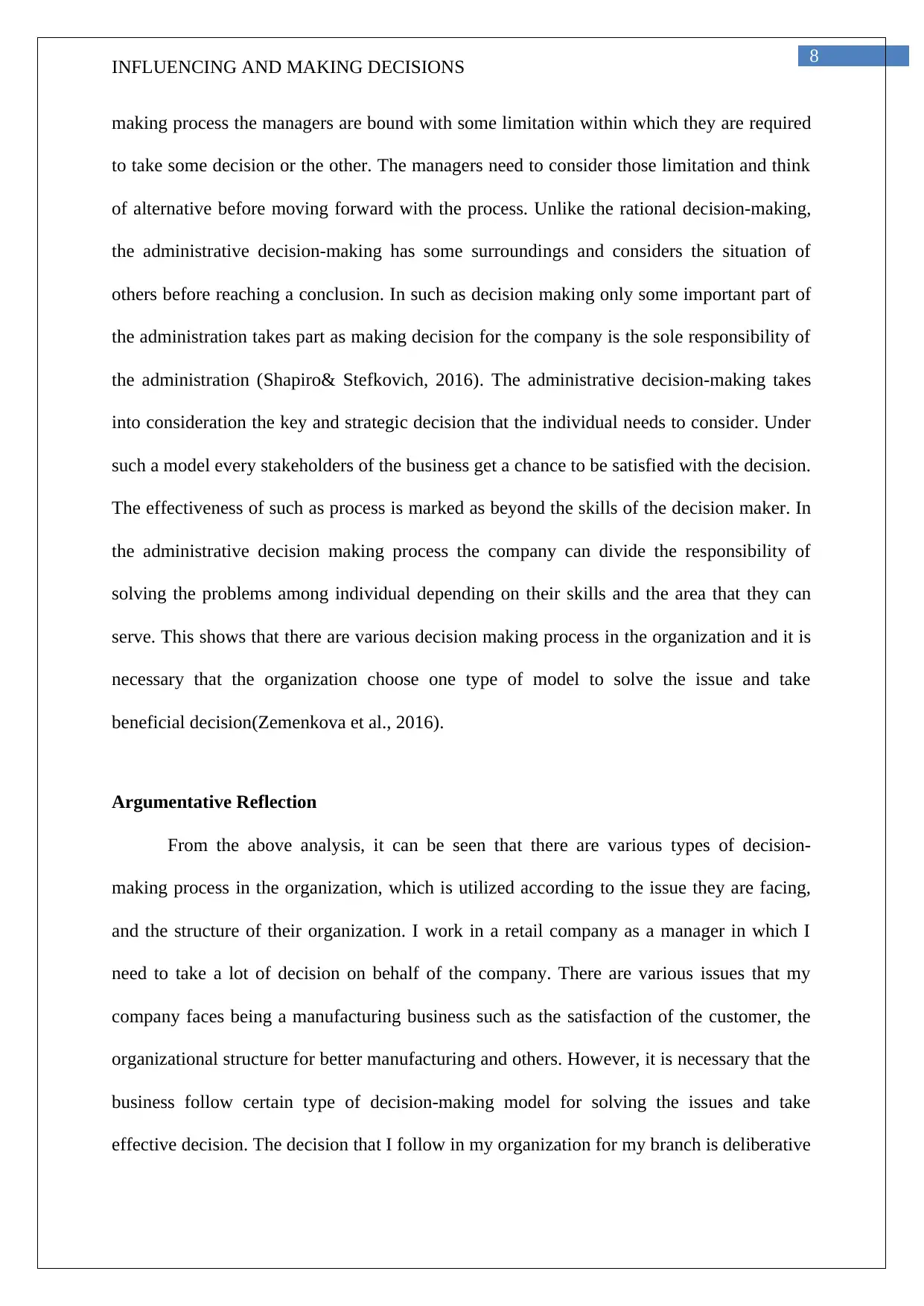
8
INFLUENCING AND MAKING DECISIONS
making process the managers are bound with some limitation within which they are required
to take some decision or the other. The managers need to consider those limitation and think
of alternative before moving forward with the process. Unlike the rational decision-making,
the administrative decision-making has some surroundings and considers the situation of
others before reaching a conclusion. In such as decision making only some important part of
the administration takes part as making decision for the company is the sole responsibility of
the administration (Shapiro& Stefkovich, 2016). The administrative decision-making takes
into consideration the key and strategic decision that the individual needs to consider. Under
such a model every stakeholders of the business get a chance to be satisfied with the decision.
The effectiveness of such as process is marked as beyond the skills of the decision maker. In
the administrative decision making process the company can divide the responsibility of
solving the problems among individual depending on their skills and the area that they can
serve. This shows that there are various decision making process in the organization and it is
necessary that the organization choose one type of model to solve the issue and take
beneficial decision(Zemenkova et al., 2016).
Argumentative Reflection
From the above analysis, it can be seen that there are various types of decision-
making process in the organization, which is utilized according to the issue they are facing,
and the structure of their organization. I work in a retail company as a manager in which I
need to take a lot of decision on behalf of the company. There are various issues that my
company faces being a manufacturing business such as the satisfaction of the customer, the
organizational structure for better manufacturing and others. However, it is necessary that the
business follow certain type of decision-making model for solving the issues and take
effective decision. The decision that I follow in my organization for my branch is deliberative
INFLUENCING AND MAKING DECISIONS
making process the managers are bound with some limitation within which they are required
to take some decision or the other. The managers need to consider those limitation and think
of alternative before moving forward with the process. Unlike the rational decision-making,
the administrative decision-making has some surroundings and considers the situation of
others before reaching a conclusion. In such as decision making only some important part of
the administration takes part as making decision for the company is the sole responsibility of
the administration (Shapiro& Stefkovich, 2016). The administrative decision-making takes
into consideration the key and strategic decision that the individual needs to consider. Under
such a model every stakeholders of the business get a chance to be satisfied with the decision.
The effectiveness of such as process is marked as beyond the skills of the decision maker. In
the administrative decision making process the company can divide the responsibility of
solving the problems among individual depending on their skills and the area that they can
serve. This shows that there are various decision making process in the organization and it is
necessary that the organization choose one type of model to solve the issue and take
beneficial decision(Zemenkova et al., 2016).
Argumentative Reflection
From the above analysis, it can be seen that there are various types of decision-
making process in the organization, which is utilized according to the issue they are facing,
and the structure of their organization. I work in a retail company as a manager in which I
need to take a lot of decision on behalf of the company. There are various issues that my
company faces being a manufacturing business such as the satisfaction of the customer, the
organizational structure for better manufacturing and others. However, it is necessary that the
business follow certain type of decision-making model for solving the issues and take
effective decision. The decision that I follow in my organization for my branch is deliberative
⊘ This is a preview!⊘
Do you want full access?
Subscribe today to unlock all pages.

Trusted by 1+ million students worldwide
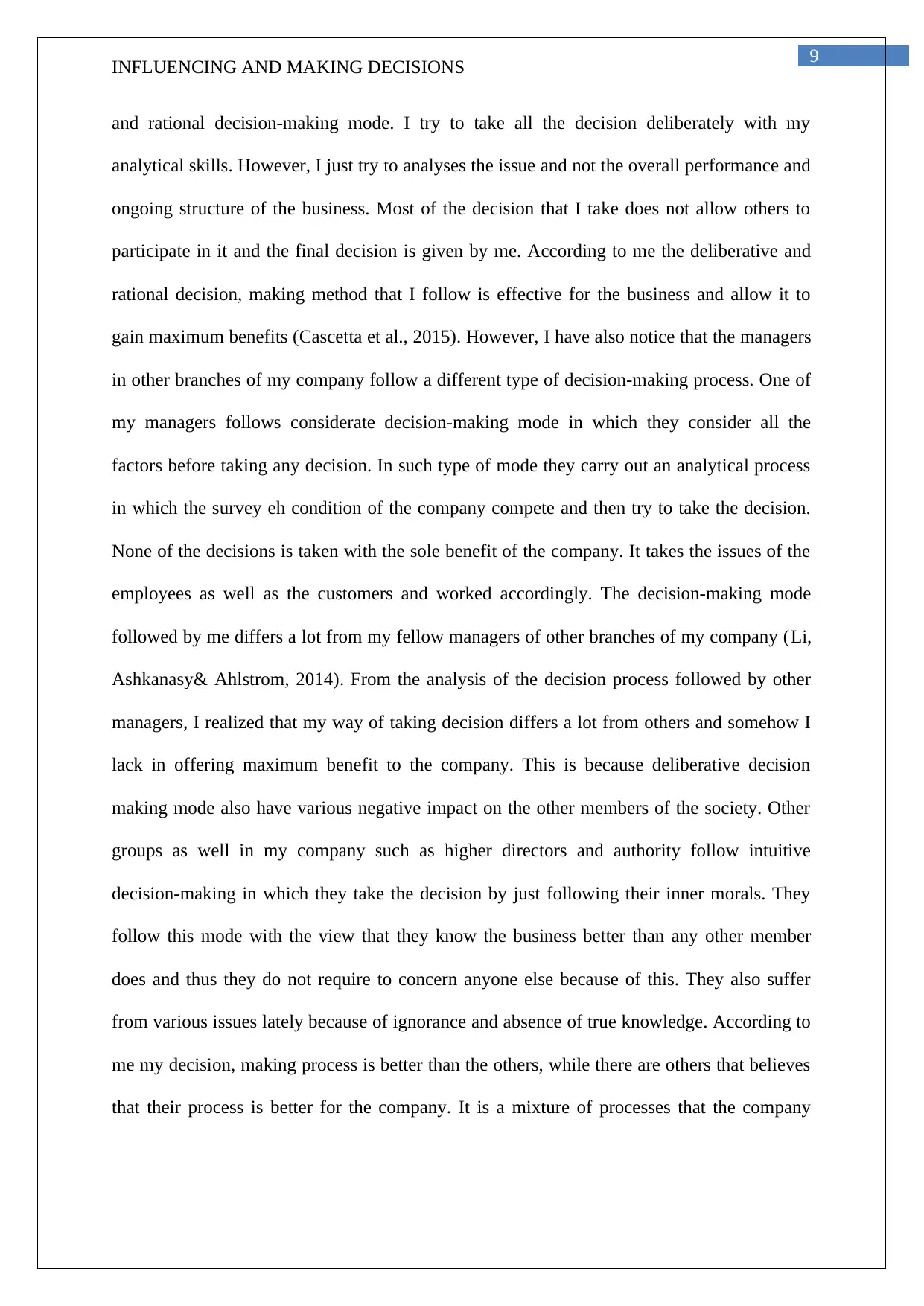
9
INFLUENCING AND MAKING DECISIONS
and rational decision-making mode. I try to take all the decision deliberately with my
analytical skills. However, I just try to analyses the issue and not the overall performance and
ongoing structure of the business. Most of the decision that I take does not allow others to
participate in it and the final decision is given by me. According to me the deliberative and
rational decision, making method that I follow is effective for the business and allow it to
gain maximum benefits (Cascetta et al., 2015). However, I have also notice that the managers
in other branches of my company follow a different type of decision-making process. One of
my managers follows considerate decision-making mode in which they consider all the
factors before taking any decision. In such type of mode they carry out an analytical process
in which the survey eh condition of the company compete and then try to take the decision.
None of the decisions is taken with the sole benefit of the company. It takes the issues of the
employees as well as the customers and worked accordingly. The decision-making mode
followed by me differs a lot from my fellow managers of other branches of my company (Li,
Ashkanasy& Ahlstrom, 2014). From the analysis of the decision process followed by other
managers, I realized that my way of taking decision differs a lot from others and somehow I
lack in offering maximum benefit to the company. This is because deliberative decision
making mode also have various negative impact on the other members of the society. Other
groups as well in my company such as higher directors and authority follow intuitive
decision-making in which they take the decision by just following their inner morals. They
follow this mode with the view that they know the business better than any other member
does and thus they do not require to concern anyone else because of this. They also suffer
from various issues lately because of ignorance and absence of true knowledge. According to
me my decision, making process is better than the others, while there are others that believes
that their process is better for the company. It is a mixture of processes that the company
INFLUENCING AND MAKING DECISIONS
and rational decision-making mode. I try to take all the decision deliberately with my
analytical skills. However, I just try to analyses the issue and not the overall performance and
ongoing structure of the business. Most of the decision that I take does not allow others to
participate in it and the final decision is given by me. According to me the deliberative and
rational decision, making method that I follow is effective for the business and allow it to
gain maximum benefits (Cascetta et al., 2015). However, I have also notice that the managers
in other branches of my company follow a different type of decision-making process. One of
my managers follows considerate decision-making mode in which they consider all the
factors before taking any decision. In such type of mode they carry out an analytical process
in which the survey eh condition of the company compete and then try to take the decision.
None of the decisions is taken with the sole benefit of the company. It takes the issues of the
employees as well as the customers and worked accordingly. The decision-making mode
followed by me differs a lot from my fellow managers of other branches of my company (Li,
Ashkanasy& Ahlstrom, 2014). From the analysis of the decision process followed by other
managers, I realized that my way of taking decision differs a lot from others and somehow I
lack in offering maximum benefit to the company. This is because deliberative decision
making mode also have various negative impact on the other members of the society. Other
groups as well in my company such as higher directors and authority follow intuitive
decision-making in which they take the decision by just following their inner morals. They
follow this mode with the view that they know the business better than any other member
does and thus they do not require to concern anyone else because of this. They also suffer
from various issues lately because of ignorance and absence of true knowledge. According to
me my decision, making process is better than the others, while there are others that believes
that their process is better for the company. It is a mixture of processes that the company
Paraphrase This Document
Need a fresh take? Get an instant paraphrase of this document with our AI Paraphraser
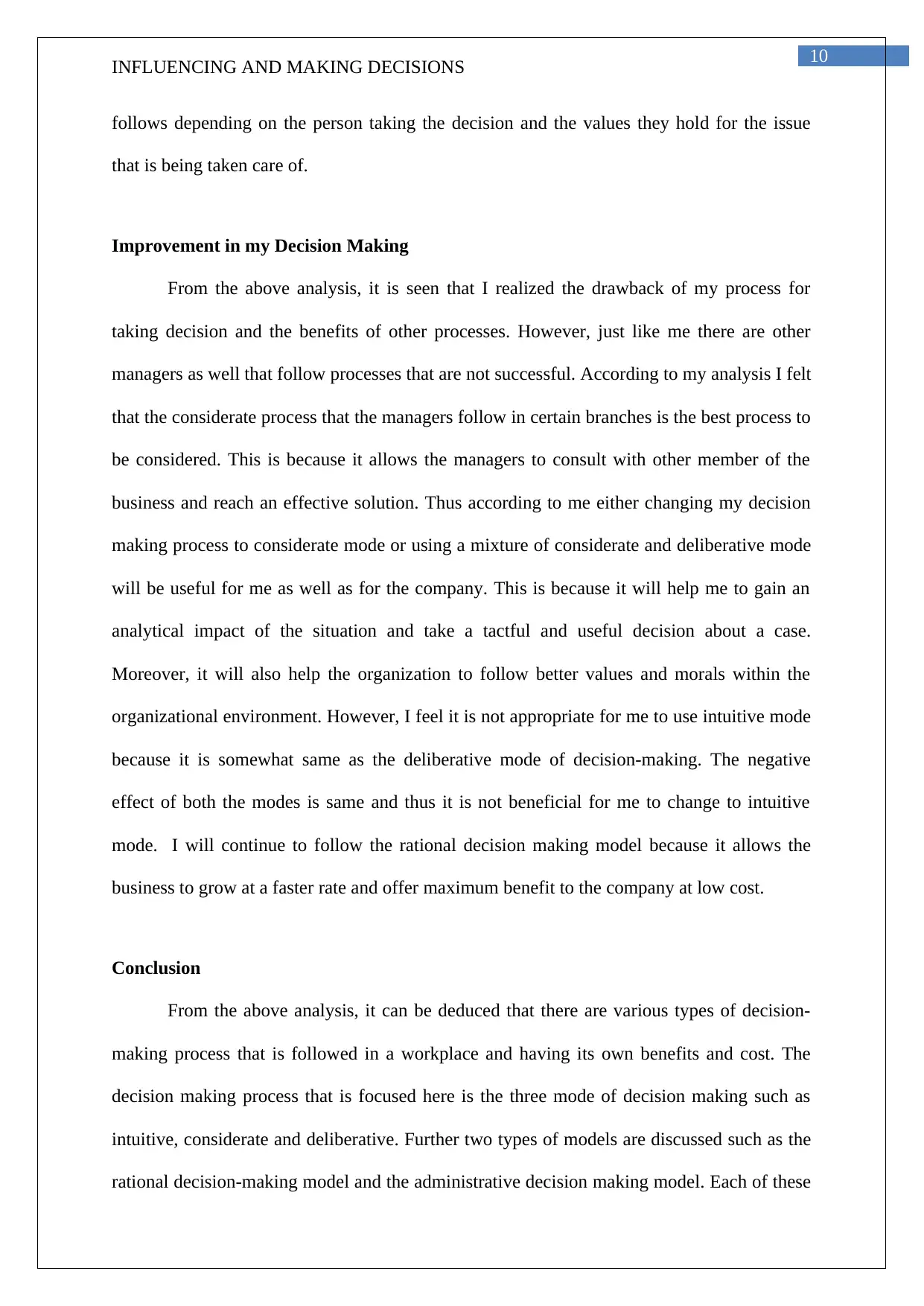
10
INFLUENCING AND MAKING DECISIONS
follows depending on the person taking the decision and the values they hold for the issue
that is being taken care of.
Improvement in my Decision Making
From the above analysis, it is seen that I realized the drawback of my process for
taking decision and the benefits of other processes. However, just like me there are other
managers as well that follow processes that are not successful. According to my analysis I felt
that the considerate process that the managers follow in certain branches is the best process to
be considered. This is because it allows the managers to consult with other member of the
business and reach an effective solution. Thus according to me either changing my decision
making process to considerate mode or using a mixture of considerate and deliberative mode
will be useful for me as well as for the company. This is because it will help me to gain an
analytical impact of the situation and take a tactful and useful decision about a case.
Moreover, it will also help the organization to follow better values and morals within the
organizational environment. However, I feel it is not appropriate for me to use intuitive mode
because it is somewhat same as the deliberative mode of decision-making. The negative
effect of both the modes is same and thus it is not beneficial for me to change to intuitive
mode. I will continue to follow the rational decision making model because it allows the
business to grow at a faster rate and offer maximum benefit to the company at low cost.
Conclusion
From the above analysis, it can be deduced that there are various types of decision-
making process that is followed in a workplace and having its own benefits and cost. The
decision making process that is focused here is the three mode of decision making such as
intuitive, considerate and deliberative. Further two types of models are discussed such as the
rational decision-making model and the administrative decision making model. Each of these
INFLUENCING AND MAKING DECISIONS
follows depending on the person taking the decision and the values they hold for the issue
that is being taken care of.
Improvement in my Decision Making
From the above analysis, it is seen that I realized the drawback of my process for
taking decision and the benefits of other processes. However, just like me there are other
managers as well that follow processes that are not successful. According to my analysis I felt
that the considerate process that the managers follow in certain branches is the best process to
be considered. This is because it allows the managers to consult with other member of the
business and reach an effective solution. Thus according to me either changing my decision
making process to considerate mode or using a mixture of considerate and deliberative mode
will be useful for me as well as for the company. This is because it will help me to gain an
analytical impact of the situation and take a tactful and useful decision about a case.
Moreover, it will also help the organization to follow better values and morals within the
organizational environment. However, I feel it is not appropriate for me to use intuitive mode
because it is somewhat same as the deliberative mode of decision-making. The negative
effect of both the modes is same and thus it is not beneficial for me to change to intuitive
mode. I will continue to follow the rational decision making model because it allows the
business to grow at a faster rate and offer maximum benefit to the company at low cost.
Conclusion
From the above analysis, it can be deduced that there are various types of decision-
making process that is followed in a workplace and having its own benefits and cost. The
decision making process that is focused here is the three mode of decision making such as
intuitive, considerate and deliberative. Further two types of models are discussed such as the
rational decision-making model and the administrative decision making model. Each of these
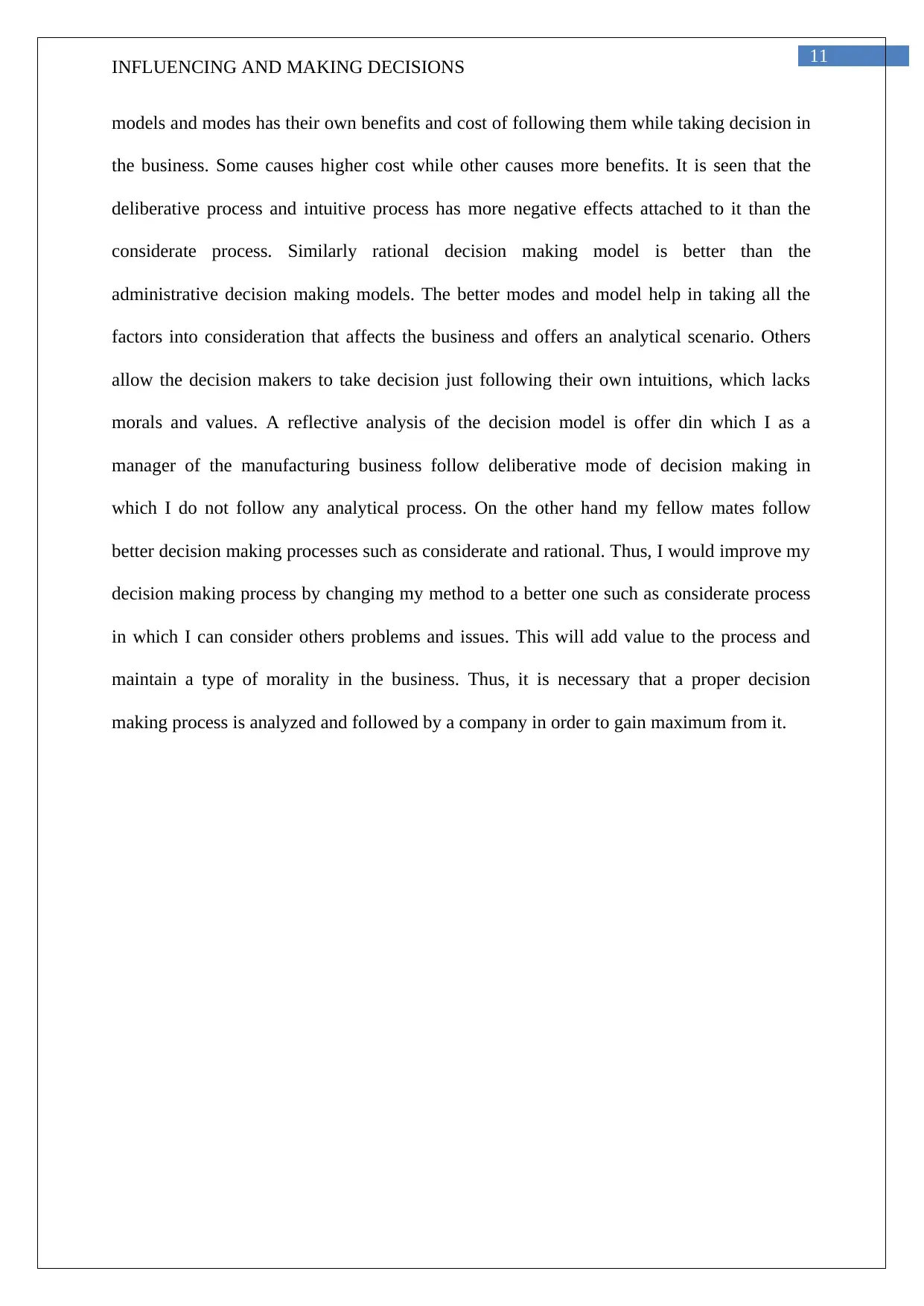
11
INFLUENCING AND MAKING DECISIONS
models and modes has their own benefits and cost of following them while taking decision in
the business. Some causes higher cost while other causes more benefits. It is seen that the
deliberative process and intuitive process has more negative effects attached to it than the
considerate process. Similarly rational decision making model is better than the
administrative decision making models. The better modes and model help in taking all the
factors into consideration that affects the business and offers an analytical scenario. Others
allow the decision makers to take decision just following their own intuitions, which lacks
morals and values. A reflective analysis of the decision model is offer din which I as a
manager of the manufacturing business follow deliberative mode of decision making in
which I do not follow any analytical process. On the other hand my fellow mates follow
better decision making processes such as considerate and rational. Thus, I would improve my
decision making process by changing my method to a better one such as considerate process
in which I can consider others problems and issues. This will add value to the process and
maintain a type of morality in the business. Thus, it is necessary that a proper decision
making process is analyzed and followed by a company in order to gain maximum from it.
INFLUENCING AND MAKING DECISIONS
models and modes has their own benefits and cost of following them while taking decision in
the business. Some causes higher cost while other causes more benefits. It is seen that the
deliberative process and intuitive process has more negative effects attached to it than the
considerate process. Similarly rational decision making model is better than the
administrative decision making models. The better modes and model help in taking all the
factors into consideration that affects the business and offers an analytical scenario. Others
allow the decision makers to take decision just following their own intuitions, which lacks
morals and values. A reflective analysis of the decision model is offer din which I as a
manager of the manufacturing business follow deliberative mode of decision making in
which I do not follow any analytical process. On the other hand my fellow mates follow
better decision making processes such as considerate and rational. Thus, I would improve my
decision making process by changing my method to a better one such as considerate process
in which I can consider others problems and issues. This will add value to the process and
maintain a type of morality in the business. Thus, it is necessary that a proper decision
making process is analyzed and followed by a company in order to gain maximum from it.
⊘ This is a preview!⊘
Do you want full access?
Subscribe today to unlock all pages.

Trusted by 1+ million students worldwide
1 out of 14
Related Documents
Your All-in-One AI-Powered Toolkit for Academic Success.
+13062052269
info@desklib.com
Available 24*7 on WhatsApp / Email
![[object Object]](/_next/static/media/star-bottom.7253800d.svg)
Unlock your academic potential
Copyright © 2020–2025 A2Z Services. All Rights Reserved. Developed and managed by ZUCOL.





